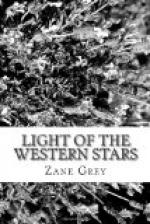By their aid Madeline saw in the foreground a great, dense herd of cattle with dark, thick streams and dotted lines of cattle leading in every direction. She saw streaks and clouds of dust, running horses, and a band of horses grazing; and she descried horsemen standing still like sentinels, and others in action.
“The round-up! I want to know all about it—to see it,” declared Madeline. “Please tell me what it means, what it’s for, and then take me down there.”
“It’s sure a sight, Miss Hammond. I’ll be glad to take you down, but I fancy you’ll not want to go close. Few Eastern people who regularly eat their choice cuts of roast beef and porterhouse have any idea of the open range and the struggle cattle have to live and the hard life of cowboys. It’ll sure open your eyes, Miss Hammond. I’m glad you care to know. Your brother would have made a big success in this cattle business if it hadn’t been for crooked work by rival ranchers. He’ll make it yet, in spite of them.”
“Indeed he shall,” replied Madeline. “But tell me, please, all about the round-up.”
“Well, in the first place, every cattleman has to have a brand to identify his stock. Without it no cattleman, nor half a hundred cowboys, if he had so many, could ever recognize all the cattle in a big herd. There are no fences on our ranges. They are all open to everybody. Some day I hope we’ll be rich enough to fence a range. The different herds graze together. Every calf has to be caught, if possible, and branded with the mark of its mother. That’s no easy job. A maverick is an unbranded calf that has been weaned and shifts for itself. The maverick then belongs to the man who finds it and brands it. These little calves that lose their mothers sure have a cruel time of it. Many of them die. Then the coyotes and wolves and lions prey on them. Every year we have two big round-ups, but the boys do some branding all the year. A calf should be branded as soon as it’s found. This is a safeguard against cattle-thieves. We don’t have the rustling of herds and bunches of cattle like we used to. But there’s always the calf-thief, and always will be as long as there’s cattle-raising. The thieves have a good many cunning tricks. They kill the calf’s mother or slit the calf’s tongue so it can’t suck and so loses its mother. They steal and hide a calf and watch it till it’s big enough to fare for itself, and then brand it. They make imperfect brands and finish them at a later time.




